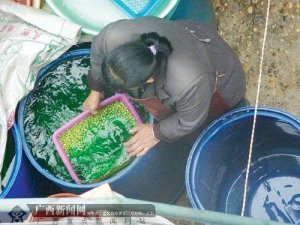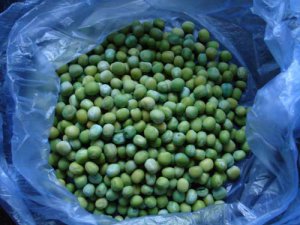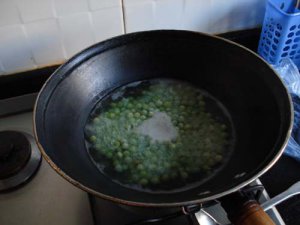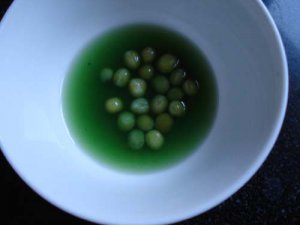- 首页
-
菜单
- 家园币
-
比特币
Financial Markets by TradingView
您正在使用一款已经过时的浏览器!部分功能不能正常使用。
- 主题发起人 eor06
- 发布时间 2011-04-29
更多选项
导出主题(文本)
游
- 最大赞力
- 0.00
- 当前赞力
- 0.00%
回复: 太可怕了
坐等小和尚
坐等小和尚
小
- 最大赞力
- 0.00
- 当前赞力
- 0.00%
回复: 太可怕了
哦,
偶来了,
相关最新资料,
你们说加拿大垃圾不垃圾?
转基因学美国跟得最快,但有好事却不追随:
加拿大这个怪物决定不跟随美国欧盟收紧染色食物法规。
Canada not following U.S.A., EU on tighter food-dye regulations
Posted on Thu, Mar 31, 2011, 4:14 pm by Sarah Schmidt, Postmedia News
Canada could be the odd man out if the United States signals Thursday it will follow the European Union and toughen up its approach to artificial food colourings in response to research showing the dyes could affect behaviour in some children.
A special panel of experts convened this week by the U.S. Food and Drug Administration to consider requiring companies to slap warnings on products containing artificial dyes, common in junk food and a range of other processed foods popular with kids.
The panel is expected to present its recommendations Thursday afternoon.
The European Union already passed new regulations last year so foods containing certain colour additives, used brighten up a product and made from petroleum products, must state on the label that they “may have an adverse effect on activity and attention in children.”
Research shows that while most children might be unaffected by food dyes, kids with behavioural disorders, such as attention deficit disorder, could have their conditions “exacerbated by exposure” to certain colour additives like Red 40, Yellow 6, Yellow 5, Green, Blue 1 and others, FDA scientists wrote in a report to its expert panel.
The mandatory warnings labels for most dyed foods sold in Europe, coupled with calls from some countries for companies to voluntarily remove the dyes altogether, has proven to be a powerful incentive for food manufacturers to switch to naturally coloured products, says the Center for Science in the Public Interest (CSPI), which petitioned to the FDA for the special review.
Health Canada doesn’t want to go that far.
The department last year recommended new regulations disallowing companies from using the general term “colour” for synthetic dyes on their labels and instead require that individual colours be identified in the ingredient lists. This could mean all food colours be listed by their common name or their numerical identifier.
This Canadian proposal mirrors the current labelling rule in the U.S. under reconsideration this week.
In a written statement to Postmedia News Thursday, Health Canada defended its more tepid proposal, now under review after consultations, as a way to deal with the “possible behavioural reactions in children associated with the ingestion of certain food colours.”
And while Health Canada assesses feedback to its labelling proposal, the department is “encouraging” food manufacturers to voluntarily declare food colours by their individual common names on prepackaged food labels.
Bill Jeffery, national co-ordinator of the Canadian branch of the CSPI, said Health Canada’s move is inadequate.
“What Canada is proposing is like moving from the stone age to the dark ages,” he said Thursday.
Jeffery’s American counterpart, Michael Jacobson, said he’s glad the FDA is reviewing the evidence linking synthetic food dyes to behavioural problems in children.
“The evidence that these petrochemicals worsen some children’s behaviour is convincing, and I hope that the FDA’s advisory committee will advise the agency to both require warning notices and encourage companies voluntarily to switch to safer natural colourings,” said Jacobson, who wants an outright ban or prominent warnings stating that “artificial colourings in this food cause hyperactivity and behavioural problem in some children.”
The dyes are commonly used in junk food and kiddie favourites like Froot Loops cereals, Pop-Tarts and Jell-O.
The food industry has repeatedly defended artificial dyes as safe since the 1970s, when questions first arose about a relationship between the dyes and behavioural problems in children.
哦,
偶来了,
相关最新资料,
你们说加拿大垃圾不垃圾?
转基因学美国跟得最快,但有好事却不追随:
加拿大这个怪物决定不跟随美国欧盟收紧染色食物法规。
Canada not following U.S.A., EU on tighter food-dye regulations
Posted on Thu, Mar 31, 2011, 4:14 pm by Sarah Schmidt, Postmedia News
Canada could be the odd man out if the United States signals Thursday it will follow the European Union and toughen up its approach to artificial food colourings in response to research showing the dyes could affect behaviour in some children.
A special panel of experts convened this week by the U.S. Food and Drug Administration to consider requiring companies to slap warnings on products containing artificial dyes, common in junk food and a range of other processed foods popular with kids.
The panel is expected to present its recommendations Thursday afternoon.
The European Union already passed new regulations last year so foods containing certain colour additives, used brighten up a product and made from petroleum products, must state on the label that they “may have an adverse effect on activity and attention in children.”
Research shows that while most children might be unaffected by food dyes, kids with behavioural disorders, such as attention deficit disorder, could have their conditions “exacerbated by exposure” to certain colour additives like Red 40, Yellow 6, Yellow 5, Green, Blue 1 and others, FDA scientists wrote in a report to its expert panel.
The mandatory warnings labels for most dyed foods sold in Europe, coupled with calls from some countries for companies to voluntarily remove the dyes altogether, has proven to be a powerful incentive for food manufacturers to switch to naturally coloured products, says the Center for Science in the Public Interest (CSPI), which petitioned to the FDA for the special review.
Health Canada doesn’t want to go that far.
The department last year recommended new regulations disallowing companies from using the general term “colour” for synthetic dyes on their labels and instead require that individual colours be identified in the ingredient lists. This could mean all food colours be listed by their common name or their numerical identifier.
This Canadian proposal mirrors the current labelling rule in the U.S. under reconsideration this week.
In a written statement to Postmedia News Thursday, Health Canada defended its more tepid proposal, now under review after consultations, as a way to deal with the “possible behavioural reactions in children associated with the ingestion of certain food colours.”
And while Health Canada assesses feedback to its labelling proposal, the department is “encouraging” food manufacturers to voluntarily declare food colours by their individual common names on prepackaged food labels.
Bill Jeffery, national co-ordinator of the Canadian branch of the CSPI, said Health Canada’s move is inadequate.
“What Canada is proposing is like moving from the stone age to the dark ages,” he said Thursday.
Jeffery’s American counterpart, Michael Jacobson, said he’s glad the FDA is reviewing the evidence linking synthetic food dyes to behavioural problems in children.
“The evidence that these petrochemicals worsen some children’s behaviour is convincing, and I hope that the FDA’s advisory committee will advise the agency to both require warning notices and encourage companies voluntarily to switch to safer natural colourings,” said Jacobson, who wants an outright ban or prominent warnings stating that “artificial colourings in this food cause hyperactivity and behavioural problem in some children.”
The dyes are commonly used in junk food and kiddie favourites like Froot Loops cereals, Pop-Tarts and Jell-O.
The food industry has repeatedly defended artificial dyes as safe since the 1970s, when questions first arose about a relationship between the dyes and behavioural problems in children.
由版主最后编辑: 2011-04-29
游
- 最大赞力
- 0.00
- 当前赞力
- 0.00%
回复: 太可怕了
3小和尚, 你这能说明什么呢? 就算美国通过那个法案, 那也就只能证明欧洲和美国对食品染色剂的控制比加拿大更严啊, 说明不了加拿大的标准比中国的低啊。
3小和尚, 你这能说明什么呢? 就算美国通过那个法案, 那也就只能证明欧洲和美国对食品染色剂的控制比加拿大更严啊, 说明不了加拿大的标准比中国的低啊。
哦,
偶来了,
相关最新资料,
你们说加拿大垃圾不垃圾?
转基因学美国跟得最快,但有好事却不追随:
加拿大这个怪物决定不跟随美国欧盟收紧染色食物法规。
Canada not following U.S.A., EU on tighter food-dye regulations
Posted on Thu, Mar 31, 2011, 4:14 pm by Sarah Schmidt, Postmedia News
Canada could be the odd man out if the United States signals Thursday it will follow the European Union and toughen up its approach to artificial food colourings in response to research showing the dyes could affect behaviour in some children.
A special panel of experts convened this week by the U.S. Food and Drug Administration to consider requiring companies to slap warnings on products containing artificial dyes, common in junk food and a range of other processed foods popular with kids.
The panel is expected to present its recommendations Thursday afternoon.
The European Union already passed new regulations last year so foods containing certain colour additives, used brighten up a product and made from petroleum products, must state on the label that they “may have an adverse effect on activity and attention in children.”
Research shows that while most children might be unaffected by food dyes, kids with behavioural disorders, such as attention deficit disorder, could have their conditions “exacerbated by exposure” to certain colour additives like Red 40, Yellow 6, Yellow 5, Green, Blue 1 and others, FDA scientists wrote in a report to its expert panel.
The mandatory warnings labels for most dyed foods sold in Europe, coupled with calls from some countries for companies to voluntarily remove the dyes altogether, has proven to be a powerful incentive for food manufacturers to switch to naturally coloured products, says the Center for Science in the Public Interest (CSPI), which petitioned to the FDA for the special review.
Health Canada doesn’t want to go that far.
The department last year recommended new regulations disallowing companies from using the general term “colour” for synthetic dyes on their labels and instead require that individual colours be identified in the ingredient lists. This could mean all food colours be listed by their common name or their numerical identifier.
This Canadian proposal mirrors the current labelling rule in the U.S. under reconsideration this week.
In a written statement to Postmedia News Thursday, Health Canada defended its more tepid proposal, now under review after consultations, as a way to deal with the “possible behavioural reactions in children associated with the ingestion of certain food colours.”
And while Health Canada assesses feedback to its labelling proposal, the department is “encouraging” food manufacturers to voluntarily declare food colours by their individual common names on prepackaged food labels.
Bill Jeffery, national co-ordinator of the Canadian branch of the CSPI, said Health Canada’s move is inadequate.
“What Canada is proposing is like moving from the stone age to the dark ages,” he said Thursday.
Jeffery’s American counterpart, Michael Jacobson, said he’s glad the FDA is reviewing the evidence linking synthetic food dyes to behavioural problems in children.
“The evidence that these petrochemicals worsen some children’s behaviour is convincing, and I hope that the FDA’s advisory committee will advise the agency to both require warning notices and encourage companies voluntarily to switch to safer natural colourings,” said Jacobson, who wants an outright ban or prominent warnings stating that “artificial colourings in this food cause hyperactivity and behavioural problem in some children.”
The dyes are commonly used in junk food and kiddie favourites like Froot Loops cereals, Pop-Tarts and Jell-O.
The food industry has repeatedly defended artificial dyes as safe since the 1970s, when questions first arose about a relationship between the dyes and behavioural problems in children.
回复: 太可怕了
自己人害自己人,让别人听见,真是笑死了。
自己人害自己人,让别人听见,真是笑死了。
游
- 最大赞力
- 0.00
- 当前赞力
- 0.00%
回复: 太可怕了
小和尚总拿一些乱七八糟的图片和文字在论坛里骗人(抓住了大家不爱看长篇文章的心理)
小和尚总拿一些乱七八糟的图片和文字在论坛里骗人(抓住了大家不爱看长篇文章的心理)
Similar threads
美食天地
中华美食(7):茄汁大虾
- 0.00 超赞 赏
- Bingoye ,#277
- 2024-01-29
- 生活・购物・亲子・教育・美食・旅游
- 1
2024-01-31有新赞
全楼:0.00
tonyhuang
- 12
2022-09-11有新回复
全楼:0.01
Hongyi Liu
- 8
2024-02-17有新回复
全楼:0.04
Nebula.Trek
家园推荐黄页
家园币系统数据
- 家园币池子报价
- 0.0097加元
- 家园币最新成交价
- 0.0101加元
- 家园币总发行量
- 1101666.53家园币
- 加元现金总量
- 12044.05加元
- 家园币总成交量
- 4098206.67家园币
- 家园币总成交价值
- 384692.02加元
- 池子家园币总量
- 396336.11家园币
- 池子加元现金总量
- 3850.24加元
- 池子币总量
- 35214.19
- 1池子币现价
- 0.2187加元
- 池子家园币总手续费
- 5731.58JYB
- 池子加元总手续费
- 595.28加元
- 入池家园币年化收益率
- 0.45%
- 入池加元年化收益率
- 4.82%
- 微比特币最新报价
- 0.087433加元
- 毫以太币最新报价
- 4.28980加元
- 微比特币总量
- 0.354108BTC
- 毫以太币总量
- 0.219250ETH
- 家园币储备总净值
- 363,770.29加元
- 家园币比特币储备
- 3.4200BTC
- 家园币以太币储备
- 15.1ETH
- 比特币的加元报价
- 87,432.70加元
- 以太币的加元报价
- 4,289.80加元
- USDT的加元报价
- 1.36815加元
- 交易币种/月度交易量
- 手续费
- 家园币
- 0.1%(0.01%-1%)
- 加元交易对(比特币等)
- 1%-2%
- USDT交易对(比特币等)
- 0.1%-0.6%








